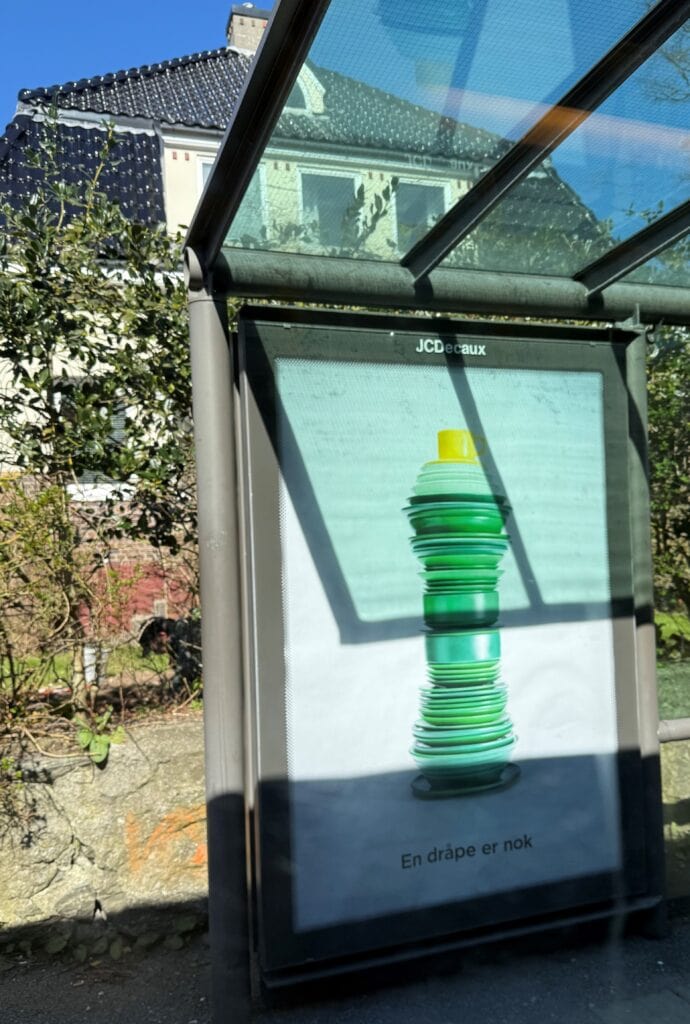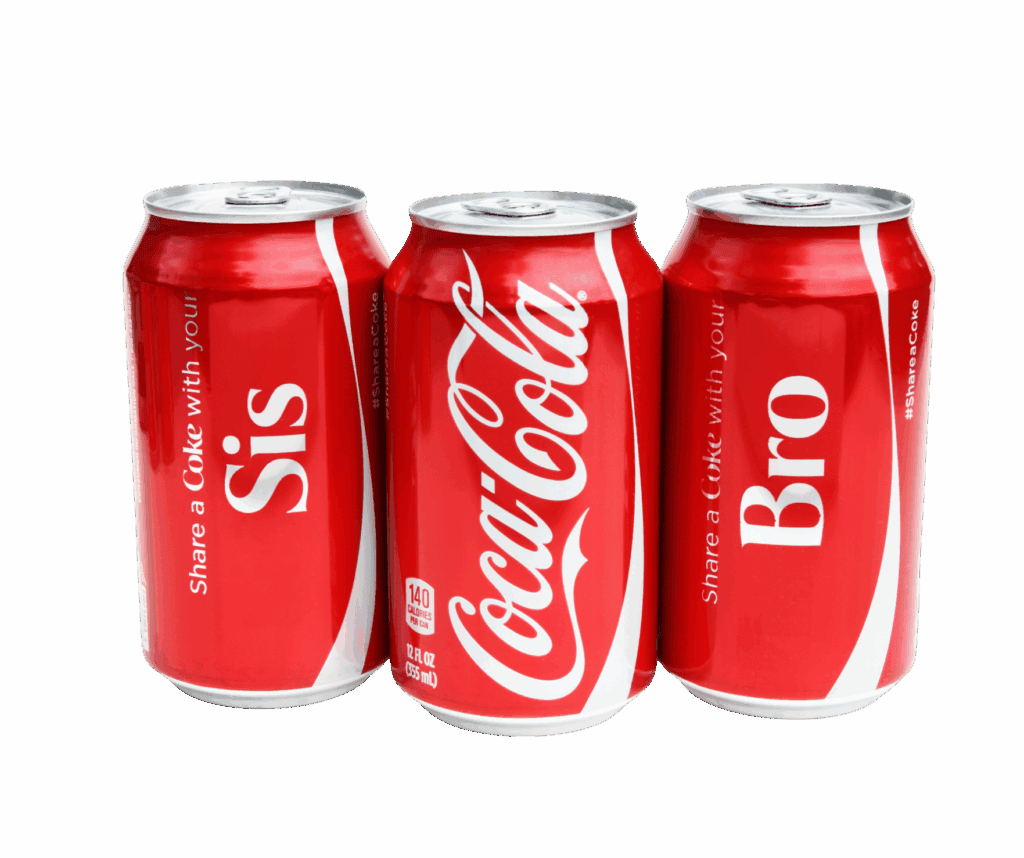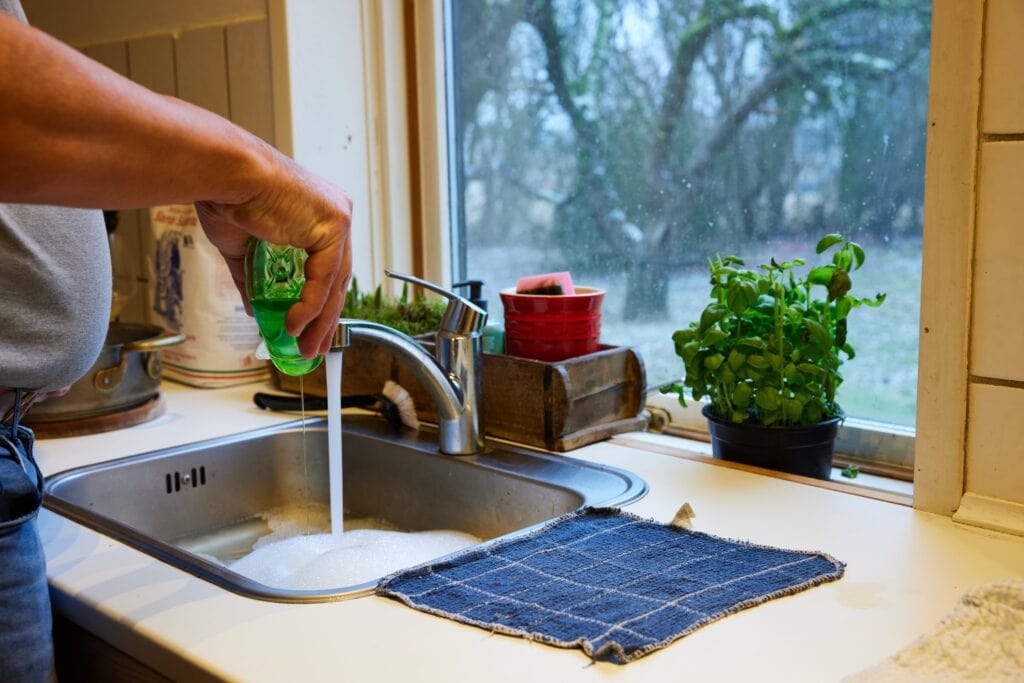This spring, Zalo® launched a campaign that really sticks in the mind. No logo. No product image. Just green and yellow tableware stacked in the iconic silhouette of a Zalo bottle, and the slogan “A drop is enough”(en dråpe er nok). The rest we supply ourselves.
For many brands this would have been a bold move. For Zalo® it is proof of the position they have achieved in the Norwegian consumer’s mind.
Many have already praised the advert for its creativity. When I set out to write about acquired distinctiveness in trademark law, this was the campaign that immediately sprang to mind – and that is precisely the point. When brand elements are so firmly established that we recognise them in an instant, they also gain legal protection.
A quick glance at the image on the left, taken at a bus stop on a summer’s day, is all it takes for Norwegians to think of Zalo®.

Acquired distinctiveness – the result of targeted brand building
To be registered, a trademark must possess distinctiveness. In other words, it must be capable of functioning as an identifier of someone’s goods or services. The mark needs something that makes it stick in consumers’ minds. A word mark should be easy to remember and recognise, and a logo must have something more distinctive than a simple geometric shape.
A trademark also cannot be purely descriptive of the goods or services. Words and symbols that describe characteristics, purpose or qualities will normally not be seen as anyone’s exclusive sign, and such terms must remain available to all players in the market.
From lacking distinctiveness to protected trademark
If a mark is initially descriptive or lacks distinctiveness, it can still gain protection through acquired distinctiveness. This occurs when a significant part of the relevant public perceives the mark as indicating commercial origin. A mark that has acquired distinctiveness can be protected even without registration. It may also be registered with the Norwegian Industrial Property Office if you can document that it is “well known as someone’s distinctive sign” in Norway.
For us, this is a key focus when we help clients register marks that do not initially meet the requirements for distinctiveness. We assess whether the mark has sufficient distinctiveness and, if not, advise on how targeted use and documentation can lay the groundwork for acquired distinctiveness. We also assist with submitting an application to the Norwegian Industrial Property Office once the conditions for acquired distinctiveness are considered fulfilled. In this way, owners of marks that have gained a strong position in the market can more easily enforce their rights. Would you like to secure your trademark? We are happy to help – get in touch or read more here.
The Zalo® trademark faces no such challenge, as it is not descriptive of soap and is therefore distinctive. Even so, the Zalo® campaign illustrates how consistent and extensive use of a mark can create an especially strong market position. Even registered marks with inherent distinctiveness may benefit from invoking acquired distinctiveness in addition to registration. This provides an extra layer of protection, as we will look at below, and serves as clear evidence of a successful branding strategy.
What does the Norwegian Industrial Property Office (NIPO) say about acquired distinctiveness?
- Proving that a trademark has acquired distinctiveness requires extensive documentation, such as market share, intensity of use, marketing efforts and surveys showing that people associate the mark with a single specific business.
- A trademark receives nationwide protection only if it is known throughout Norway for the relevant goods or services.
- Acquired distinctiveness can also provide exclusive rights on a local level, but registration cannot be claimed on that basis.
- You can read more about acquired distinctiveness from the Norwegian Industrial Property Office here: Establishment by use
The shop shelf and peripheral vision

Marketing is not just about TV commercials and full-page adverts. In the shop we often move with our eyes in motion – we squint, scan the shelves in our peripheral vision, and make decisions in seconds.
Strongly established brand elements allow the brain to recognise a product even when we catch only a flash of its colour or outline. It is a bit like recognising a friend from afar by their walk or hairstyle. For a market leader this is gold: you win both in conscious attention and in that fast, subconscious recognition.
But even strong distinctiveness can fade. If a colour or shape becomes generic – or is not defended against imitators – the distinctiveness may be lost. If shop shelves fill up with “lookalikes” from budget ranges using the same colour and shape, consumers will not necessarily reach for the original. That is why active enforcement is a key task for the brand owner to maintain market position.
The bottle’s shape and colour – protection without registration
The Zalo® advertising campaign has achieved something important: reminding consumers – and competitors – who “owns” this particular combination of green and yellow colours and the bottle silhouette, as well as the slogan “en dråpe er nok”.
The recent dispute over ownership of the colour Stratos®-blue shows how important such reminders can be. They can reinforce a brand’s position if it is later challenged. In the Stratos case, the appeal board emphasised, among other things, that Stratos® has been sold in blue packaging since 1936 and had therefore “worn its way to distinctiveness”. Such long-standing and consistent use is precisely what can make colours and shapes legally protected, even without registration.
The Zalo® bottle has been a fixture in Norwegian kitchens for decades. This means competitors must tread carefully if they come too close to this combination of shape and colour. At the same time, it is worth noting that green is a very common colour choice for washing-up liquids in general. It would therefore be almost impossible to gain exclusive rights to the green colour alone. But combined with the bottle’s shape and the yellow cap, consistent marketing over time can build acquired distinctiveness.
When fragments are enough
Zalo®’s campaign shows that you don’t always need to display the entire product or brand to make a clear statement. A green-and-yellow colour tone, the familiar bottle silhouette and the slogan “En dråpe er nok” are enough for consumers to immediately link it to Zalo® and washing-up liquid. This ability to be recognised from only parts of the brand is the result of long-term, consistent use, and demonstrates how strongly established elements can serve both as powerful creative tools and as legal protection.

Coca-Cola® has also used a similar strategy several times. They have replaced the famous brand name with words like “Sis”, “Bro” or various personal names, while keeping the characteristic red colour and design. As a result, the brand remains instantly recognisable, even without the name.
This also shows why companies should think carefully before rebranding established trademarks. Changes to shape, colour or other distinctive elements can weaken the recognition built up over many years – and with it the value in both the market and legal protection. That does not mean brands should never refresh themselves; they must adapt to time and trend. But changes should be made with a clear understanding of what truly creates distinctiveness and recognition. Otherwise, you risk dismantling more than you build.
How we can help you protect your brand
For more than 75 years, Håmsø has helped businesses protect and develop their brands. We offer everything from strategic advice and preliminary searches to the preparation of national and international trademark applications. We assist with renewals, support in opposition and appeal cases, and negotiate consents.
Håmsø has assisted everyone from established market leaders to start-ups, and has, for example, helped Pizzabakeren® secure registration of its trademark as acquired distinctiveness for pizza and take-away services throughout Norway.
Whether you need to secure rights to colours, shapes, slogans or logos, or want a comprehensive strategy to protect your trademark over time, we can help safeguard your brand.
